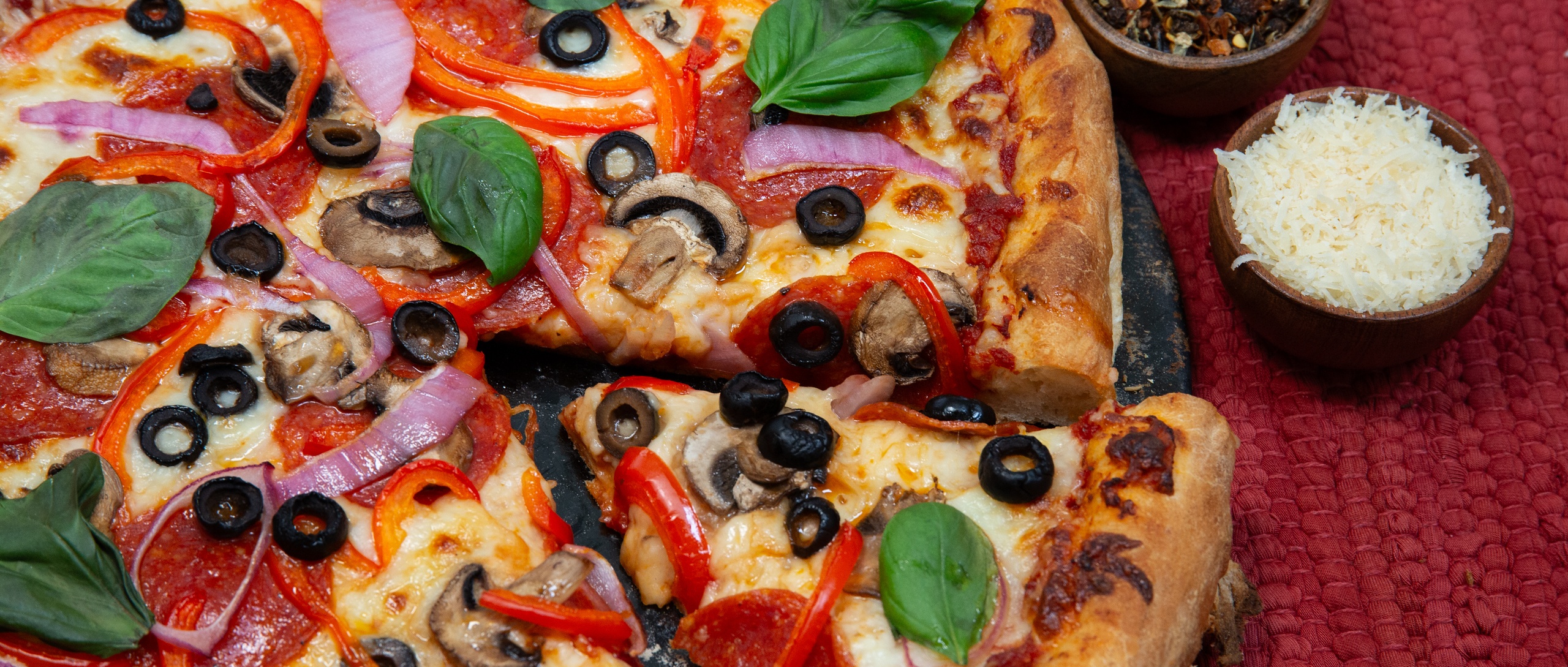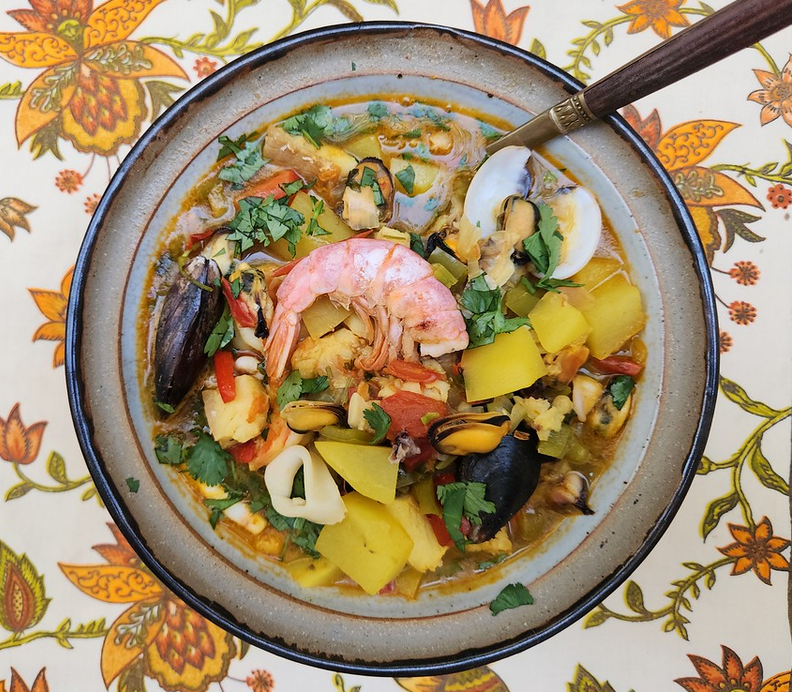
Although widely available nearly everywhere in America, making pizza yourself is definitely worth the effort as the results can be fantastic and you can make it exactly the way you want!
On our Worldview Project trips to Tecate, Mexico, we always visit the local farmers' market. There are a large variety of hot Mexican food to choose from , but by far the longest line was for pizza! Pizza is enjoyed around the planet, and while it is considered Italian food, it has a significant place in the American diet.
There are many predecessors to pizza if you define pizza as a flat bread, topped with various ingredients and then baked in an oven. Ancient Greeks prepared plakous, the Romans have eaten focaccia for centuries. However, modern day pizza seems to have its origins in Naples, Italy. In the 16th century one could find a street food based on a galette flatbread sold under the name of "pizza". But it was contact with the New World that led to the innovation that is considered (at least until very recently), a primary ingredient; tomatoes. By the late 18th century, pizza became very popular in Naples and although it was most favored by poorer residents of the city, after a while it became quite sought after by tourists visiting Naples. A popular tale posits that the Neapolitan pizza maker Raffaele Esposito prepared a pizza made with tomatoes, mozzarella cheese, and basil (the red, white and green colors in honor of the Italian flag) to honor the Queen consort of Italy, Margherita of Savoy. Subsequently that most common variety of pizza has become widely known (as it is today) as Pizza Margherita. For quite some time, pizza was sold from open-air stands and pizzerias, but eventually it became popular in Italian restaurants as well. In Italy today, the two most popular (and considered by purists to be the only legitimate pizza) are Pizza Marinara and Pizza Margherita. Marinara is the more basic of the two varieties, with an herbed tomato sauce, garlic and olive oil. The true Neapolitan Pizza Association maintains strict standards for what they consider to be "true" pizza, specifying that it should be cooked in a wood-fired oven, hand kneaded and stretched, have a thin crust, and not be larger than approximately 14 inches in diameter.
Pizza made its first appearance in the United States in the late 19th century, brought by Italian immigrants. Not surprisingly it was therefore found mostly in cities that had growing Italian communities on the eastern seaboard, but as far west as Chicago and St. Louis. Keeping its "inexpensive street food' heritage, the first pizza in America was sold by street peddlers who wore wide-rimmed metal hats on which pizza slices were arranged. In the early days of pizza in America, a slice could be had for two cents, but in some cases it was sold according to how much the buyer could afford, so more money got one a bigger slice. There are many contenders for the title of "first pizza in America" among which were pizza concessions in Chicago, Boston, and New York in the first decade of the 1900's. Until the conclusion of WWII, pizza in America was mostly enjoyed by Italians. However, US soldiers returned from being stationed in Italy with a hankering for pizza, and subsequently pizza became immensely popular throughout the United States. Until quite recently, pizza generally resembled the Italian versions and eventually olives, onions, green peppers, Italian sausage, pepperoni and at least in Philadelphia, anchovies all became popular toppings. My own sense is that East Coast pizzas tend to feature more sauce and West Coast pizzas are more cheesy. In 1943 (before the war's end), Pizza Uno was founded and a new wrinkle happened in the story with the invention of the Chicago deep dish pizza, in which the pizza is much deeper and has a double layer of ingredients separated by a layer of dough. Somewhat recently I visited Chicago and tried Giordano's deep dish pizza, and I confess that my original skepticism was delightfully disproved by my very first bite! I grew up in Philadelphia where the question "want to go out for a pie?" indicates a quest for pizza, not fruit pies.
Nowadays the sky is the limit for pizza styles and ingredients. Perhaps the most notable style to develop that diverged from the standard Italian style of pizza was the "Hawaiian Pizza," which included pineapple and ham. Canadians claim credit for the Hawaiian Pizza, and recently there has been a twitter kerfuffle on the permissibility of fruit on pizza, with Prime Minister Justin Trudeau tweeting: "I have a pineapple. I have a pizza. I stand behind this Southwestern Ontario creation. #teampineapple." However my favorite tweet in this pizza war is: "People think Canada is nice but they invented pineapple on pizza so I guess not." Purists might find it revolting, but today you can find a huge variety of pizza ingredients and styles. In contrast to pizza's humble roots, gourmet pizzas are now popular and employ all sorts of exotic ingredients. As we always say, experiment!
The following recipe is for a fairly standard version of Italian-American Pizza. We give a recipe for the sauce, but if you want to buy pre-prepared sauce I recommend you check the label's ingredients as some versions include a considerable and very noticeable amount of sugar. Some people feel that sugar in Italian sauces counteract the acidity of the tomatoes, but in fact, at least in terms of basic chemistry, sugar does not interact with acids. When we are not making our own sauce, we prefer Ragu as it seems to have less sugar than other brands we have tried. One can also purchase pizza shells, which you can cover with sauce and toppings before baking; but despite the convenience offered by such a option, your results will not much resemble actual pizza (but each to his own!). We use a bread machine to prepare our dough. You can hand knead the dough, the Associazione Verace Pizza Napoletana will be quite approving, but alas there will be little difference if you let a bread machine do all the work! Similarly, tossing and stretching the dough with your hands is the best way, but either we are quite untalented or this requires considerable skill that we have not mastered, so we roll the dough on a pastry board and stretch it to the desired shape. Again, not the preferred method, but perfectly fine if you are more interested in taste and texture than you are interested in following hallowed tradition!
How the ingredients are festooned on the pizza, both in terms of density and proportions is up to you. We start with a layer of sauce, smoothed out by the back of a large spoon. On this we add a considerable amount of shredded mozzarella cheese. If you buy shredded cheese, many of the commercial varieties say "low moisture" which works perfectly fine. They we add the pepperonis, doing our best to completely cover the pie. After this come the mushrooms, onions, red peppers, olives and sometimes artichoke hearts. Again, choose the ingredients you like best and use and much or as little of them as suits you. Normally we also use basil, which is one of the original ingredients for Neapolitan pizza and they are a wonderful compliment adding just a touch of non-sugary sweetness to the dish.
We have tried both a pizza stone and a perforated pizza pan with good results. Using a plain pizza pan is possible but unless your oven can get very hot, the bottom of the crust might not get as crispy.
Making the Dough
Ingredients:
- 3/4 cup warm (80°) water
- 1 tablespoon extra virgin olive oil
- 1 tablespoon sugar
- 1 1/2 Teaspoon salt
- 1 tablespoon dry milk
- 2 1/4 cups bread flour (all purpose flour is ok, but nearly as good)
- 1 teaspoon active dry yeast
Preparation:
Either:
- Follow directions for your bread machine.
Or:
- Pour warm water is a large mixing bowl.
- Sprinkle yeast over the warm water and wait 5 minutes.
- Whisk sugar, oil, salt and dry milk into water.
- Mix in flour thoroughly to create a sticky dough.
- Transfer dough to a different oiled mixing bowl.
- Brush dough with olive oil.
- Put bowl with dough it in a warm place.
- Wait until the dough doubles in size (about 1 hour).
- On a lightly floured pastry board or cutting board, knead the dough for two minutes.
- Some cooks suggest storing the dough in your refrigerator for 2 to 24 hours before using. But we have found it works just fine if you omit this step (perhaps because we use bread flour).
Making the Sauce:
Ingredients:
- 1- 15 ounce can tomato sauce or crushed tomatoes
- 6 ounces tomato paste
- 1 teaspoon extra virgin olive oil
- 2 teaspoons crushed garlic
- 1 teaspoon dried oregano
Preparation:
- Mix all ingredients thoroughly in a sauce pan.
- On medium low simmer the sauce for ten minutes stirring frequently to avoid burning.
Pizza Assembly:
Toppings:
- 1 pound of shredded mozzarella cheese
- 1 bunch of fresh basil
- 8 ounces of thinly sliced pepperoni
- 8 ounces of thinly sliced fresh Mushrooms (brown or white)
- 1 small onion sliced very thin
- 1 red bell pepper sliced in thin strips)
- 1 can sliced black olives
Preparation:
- Preheat your oven to the highest temperature it will heat to. (Commercial pizza ovens get much hotter than home ovens.)
- Roll and stretch the pizza dough to fit your pizza stone or pan. The dough should be thicker at the edges.
- Cover the pizza dough with a layer of pizza sauce.
- Cover the sauce with a thick layer of mozzarella and gently pat the cheese down.
- Evenly distribute the pepperoni.
- Distribute the remaining ingredients on top of the pepperoni either artistically or haphazardly.
- Cook the pizza until the edges of the crust are nicely browned (time varies depending on how hot your oven can get).
- Remove pizza from oven when done, wait a minute or two and then slice. Note: Investing in a pizza cutter is a good idea!.
Boun Appetite!
Recipe by T. Johnston-O'Neill
Photo by Kathleen Johnston









